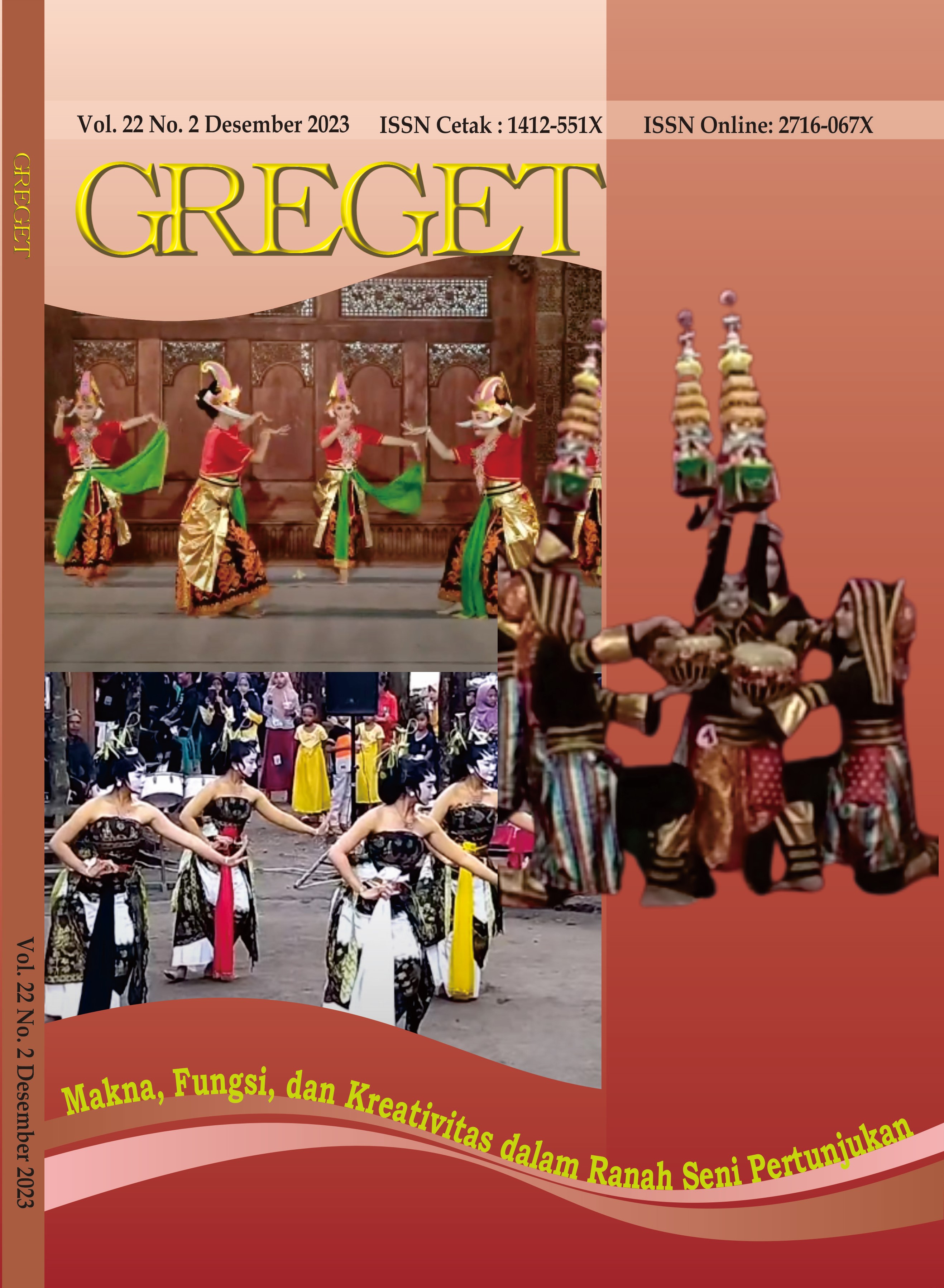KREATIVITAS DJOKO PRAKOSA DALAM KARYA TARI KRIDHA DWIPANGGA DI KABUPATEN SRAGEN
DOI:
https://doi.org/10.33153/grt.v22i2.5601Keywords:
Kridha Dwipangga dance, Form, Creative processAbstract
This research problem was formulated as a form of Kridha Dwipangga Dance performance which explains Djoko Prakosa's creative process. The results of this research show that the Kridha Dwipangga dance is a choreography and creativity of Djoko Prakosa with the theme of elephant fauna. Kridha Dwipangga Dance is intended as a form of education, tourism, and is expected to become an icon of Sragen Regency. The intended form of education is that the Kridha Dwipangga dance can be taught as learning material for Elementary School (SD) – Junior High School (SMP) levels. Apart from that, there is also education to introduce the Sangiran Archaeological Site to students. The form of tourism intended is related to the Circular Letter received by Sragen Regency from the Central Java Province Tourism and Culture Office so that each region can develop its tourism potential, including artistic and cultural potential. For this reason, Djoko Prakosa was asked to create a typical dance from Sragen Regency, hereinafter called the Kridha Dwipangga Dance. It is hoped that the iconic form of the Kridha Dwipangga dance will strengthen and publicize the Sangiran Archaeological Site which reveals many facts about well-known animal fossils, including elephants which are visualized in the form of dance. The Kridha Dwipangga dance icon presented by a group of female dancers inspired by the strong, protective and nurturing character of the elephant animal is a reflection of the Regent's attitude and responsibilities in running the government of Sragen Regency.
Downloads
References
Hadi, Y. S. (2003). Aspek-aspek Koreografi Kelompok. eLKPI.
Hidajat, R. (2017). Kreativitas Koreografi. Surya Pena Gemilang.
Humardani. (1982). Kumpulan Kertas Tentang Kesenian. ASKI Surakarta.
Humphrey, D. (1983). The Art of Making Dance (Sal Murgiyanto Penerj.). Direktorat Kesenian Jakarta.
Khayam, U. (1981). Seni, Tradisi, Masyarakat. Sinar Harapan.
Koentjaraningrat. (1990). Sejarah Teori Antropologi II. Universitas Indonesia Press.
Lexy, J. M. (1993). Metodologi Penelitian Kualitatif. PT Remaja Rosdakarya.
Maryono. (2015). Analisa Tari. ISI PRESS.
Munandar, U. (2002). Kreatifitas dan Keberbakatan, Strategi Mewujudkan Potensi Kreatif dan Bakat. Gramedia Pustaka Utama.
Murgiyanto, S. (1983). Seni Menata Tari. Dewan Kesenian Jakarta.
Murgiyanto, S. (1986). Pengetahuan Elemen-Elemen Tari dari Beberapa Masalah tari. Direktorat Kesenian Jakarta.
Prihatini, N. S., dkk. (2007). Joged Tradisi Gaya Kasunanan Surakarta. ISI Press.
Royce, A. P. (2007). Antropologi Tari. Terj. F.X. Widaryanto. STSI Press.
Sari, F. M., & Prihatini, N. S. (2019). Kreativitas Dwiyasmono dalam Karya Tari Harjuna Keratarupa. Greget, 18(1), 63-74.
Slamet. (2016). Melihat Tari. Citra Sain LPKBN.
Soedarsono, R. M. (1972). Komposisi Tari Elemen-Elemen Dasar. ASTI Yogyakarta.
Soedarsono, R. M. (1986). Pengantar Pengetahuan dan Komposisi Tari, dalam Pengetahuan Elementer Tari dan Beberapa Masalah Tari. Direktorat Kesenian Proyek Pengembangan Kesenian Jakarta Departemen Pendidikan dan Kebudayaan.
Supanggah, R. (2007). Bothekan Karawitan II. ISI Press.
Sumaryanto, T. (2007). Pendekatan Kuantitatif dan Kualitatif dalam Pendidikan Seni. UNNES Press.
Narasumber
Arum Trianingsih Himawan (24 tahun) pembantu perancang kostum Tari Kridha Dwipangga. Surabaya, Jawa Timur.
Chrisan Tiyansa (23 tahun) penari Tari Kridha Dwipangga. Sragen, Jawa Tengah.
Harist Harjanti Wijaya Mulya Catur (26 tahun) pengajar Tari Kridha Dwipangga. Sragen, Jawa Tengah.
Monica Sugiyanti (45 tahun) kepala Seksi Dinas Pariwisata dan Kebudayaan Kabupaten Sragen. Sragen, Jawa Tengah.
Rochmat Djoko Prakosa (56 tahun) pencipta sekaligus penyusun Tari Kridha Dwipangga. Surabaya, Jawa Timur.
Sri Haryanti (40 tahun) penggiat seni sekaligus pengajar Tari Kridha Dwipangga di Kabupaten Sragen. Sragen, Jawa Tengah.
Videografi
Rohmat Djoko Prakosa. 2021. “Tari Kridha Dwipangga”. Koleksi Pribadi.
Downloads
Published
How to Cite
Issue
Section
License
Copyright (c) 2023 Intan Hanny Pertiwi, Budi Setyastuti

This work is licensed under a Creative Commons Attribution-ShareAlike 4.0 International License.
Copyright
Authors who publish with GREGET agrees to the following terms:
- Authors retain copyright and grant the journal right of first publication with the work simultaneously licensed under a Creative Commons Attribution-ShareAlike 4.0 (CC BY-SA 4.0) that allows others to share the work with an acknowledgment of the work's authorship and initial publication in this journal.
- Authors are able to enter into separate, additional contractual arrangements for the non-exclusive distribution of the journal's published version of the work (e.g., post it to an institutional repository or publish it in a book), with an acknowledgment of its initial publication in this journal.
- Authors are permitted and encouraged to post their work online (e.g., in institutional repositories or on their website) prior to and during the submission process, as it can lead to productive exchanges, as well as earlier and greater citation of published work.









